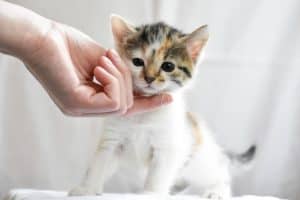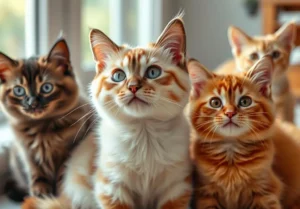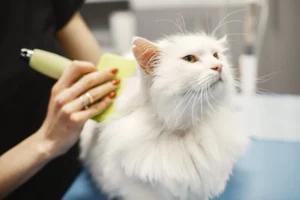Have you ever wondered why your cat cries when you close the door? It can be frustrating and puzzling to see your furry friend meowing endlessly when you try to have some privacy. But fear not, there are reasons behind this behavior that can help you better understand and address your cat’s needs.
The reason behind your cat’s cries when you close the door is rooted in their desire for social interaction and territory marking.
Cat Separation Anxiety: What Is It?
Have you ever wondered why your cat cries incessantly when you close the door behind you? It could be a sign of cat separation anxiety. Cats, just like humans, can experience anxiety when they feel separated from their owners. This anxiety can manifest in various behaviors, including excessive meowing, pacing, and even destructive tendencies.
When your cat cries when you close the door, it may be their way of expressing their distress at being left alone. They rely on your presence for comfort and security, and when you leave them behind closed doors, they feel isolated and anxious. Understanding this behavior can help you address your cat’s needs and provide them with the reassurance they require.
If your cat exhibits signs of separation anxiety, it’s essential to create a safe and comforting environment for them when you’re away. Providing them with toys, treats, and comfortable spaces to relax can help alleviate their stress and make them feel more at ease. Additionally, spending quality time with your cat when you’re home can strengthen your bond and reduce their anxiety when you have to leave.
For more information on cat separation anxiety and how to help your feline friend cope, check out this helpful resource from the American Society for the Prevention of Cruelty to Animals (ASPCA): Coping with Separation Anxiety in Cats.
Need for Territory: Why Does Your Cat Mark Its Territory?
Closing the door on your cat might trigger another instinctual behavior – territorial marking. Cats are known for being territorial creatures, and vocalization is one way they communicate their ownership and establish boundaries. When you shut the door, your cat may cry or meow to assert their presence and claim that space as their territory.
By vocalizing their distress at the closed door, your cat is essentially saying, “This is my space, and I want to be with you.” They may also be calling out for you to let them in, so they can feel safe and secure in their designated area. Understanding this behavior can help you respond appropriately and maintain a harmonious relationship with your feline companion.
To address your cat’s need for territory, consider providing them with designated spaces in your home where they feel comfortable and secure. By creating a cat-friendly environment with cozy beds, scratching posts, and perches, you can satisfy their natural instincts and reduce their urge to mark their territory through vocalization.
Remember, your cat’s cries when you close the door are a way for them to communicate their needs and desires. By acknowledging their territorial instincts and creating a safe space for them to thrive, you can help your feline friend feel more secure and content in their home.
Attention-Seeking Behavior: Is Your Cat Just Lonely?
Have you ever noticed your cat crying when you close the door? Well, it might just be seeking attention! Cats are social creatures, and they can get lonely when left alone. So, when you shut the door, your feline friend might start vocalizing to let you know it wants some company. If your cat craves attention, try spending some quality time with it before you have to close the door. Play with them, give them some pets, or even just sit near them for a while. This might help reduce their need to cry for attention when you’re not around.
Fear of Isolation: Does Your Cat Fear Being Left Alone?
It can be tough for cats to be separated from their favorite human. When you close the door, your cat might interpret it as being left alone, which can trigger fear of isolation. This fear can lead to increased vocalization as a way for your furry friend to express its distress. To help alleviate this fear, consider leaving some comforting items, such as a worn piece of your clothing or a favorite toy, when you have to close the door. This can provide a sense of familiarity and security for your cat, reducing their anxiety about being alone.
Lack of Stimulation: Could Boredom Be the Cause?
Is your furry feline friend feeling a little restless? When you close the door, your cat may start crying because they crave mental or physical stimulation. Cats are curious creatures who thrive on exploration and play. If they feel confined and lack stimulation, they may voice their discontent through meowing.
To combat this behavior, consider providing interactive toys, scratching posts, and engaging activities for your cat. Creating a stimulating environment can keep them entertained and mentally sharp, reducing the likelihood of excessive vocalization when doors are closed.
Additionally, ensure your cat has access to different areas of the house and opportunities for exploration. This way, they can satisfy their natural instincts and expend their energy, leading to a happier and quieter household overall.
For more tips on keeping your cat stimulated and content, check out this helpful resource on environmental enrichment for indoor cats: Indoor Cat Enrichment Tips
Medical Issues: When to Consider Health Problems
When your cat cries persistently at closed doors, it could be a sign of an underlying health issue. Sometimes, cats vocalize to express discomfort or pain, prompting them to seek your attention when doors separate them from you. If your cat’s crying seems excessive or out of the ordinary, it may be time to consult with a veterinarian.
Keep an eye out for other signs of potential health problems, such as changes in eating habits, litter box issues, or lethargy. These could indicate a more serious medical issue that requires professional evaluation and treatment.
If your cat continues to cry at closed doors despite efforts to provide stimulation and enrichment, it’s crucial to rule out any underlying health concerns. Your pet’s well-being is paramount, so don’t hesitate to schedule a vet visit for a thorough examination and proper diagnosis. Your cat’s cries could be their way of telling you that something isn’t quite right, and it’s essential to address any potential health issues promptly.
Tips for Addressing Your Cat’s Crying Behavior
Does your feline friend turn into a chatterbox the moment you shut the door? Don’t worry, you’re not alone in this puzzling situation! Cats can be quite vocal when they feel separated or anxious. Here are some tips to help address your cat’s crying behavior:
Provide Enrichment : Make sure your cat has plenty of toys, scratching posts, and cozy spots to explore and play with while you’re behind closed doors. Keeping them entertained can help alleviate stress and boredom.
Gradual Desensitization : If your cat becomes distressed when doors are closed, try a desensitization technique. Start by closing the door for short periods while you’re still in the room, gradually increasing the time over days or weeks.
Separation Anxiety Solutions : For cats prone to separation anxiety, consider using pheromone sprays or diffusers to create a calming environment. These products mimic natural feline pheromones and can help reduce stress levels.
Interactive Playtime : Spend quality time engaging in interactive play sessions with your cat to strengthen your bond and provide mental stimulation. This can help redirect their focus from the closed door to positive interaction with you.
Consult a Professional : If your cat’s crying behavior persists despite trying these tips, it may be beneficial to consult with a veterinarian or animal behaviorist. They can provide further insight and recommendations tailored to your cat’s specific needs.
Remember, each cat is unique, so it may take some trial and error to find the right approach for your furry companion. With patience and understanding, you can help your cat feel more comfortable and secure, even when doors are closed.
For additional insights on cat behavior and training, check out this helpful resource on Cat Behavior Problems and Solutions.
Alex, a passionate animal lover, has experience in training and understanding animal behavior. As a proud pet parent to two dogs and three cats, he founded AnimalReport.net to share insights from animal experts and expand his knowledge of the animal kingdom.




